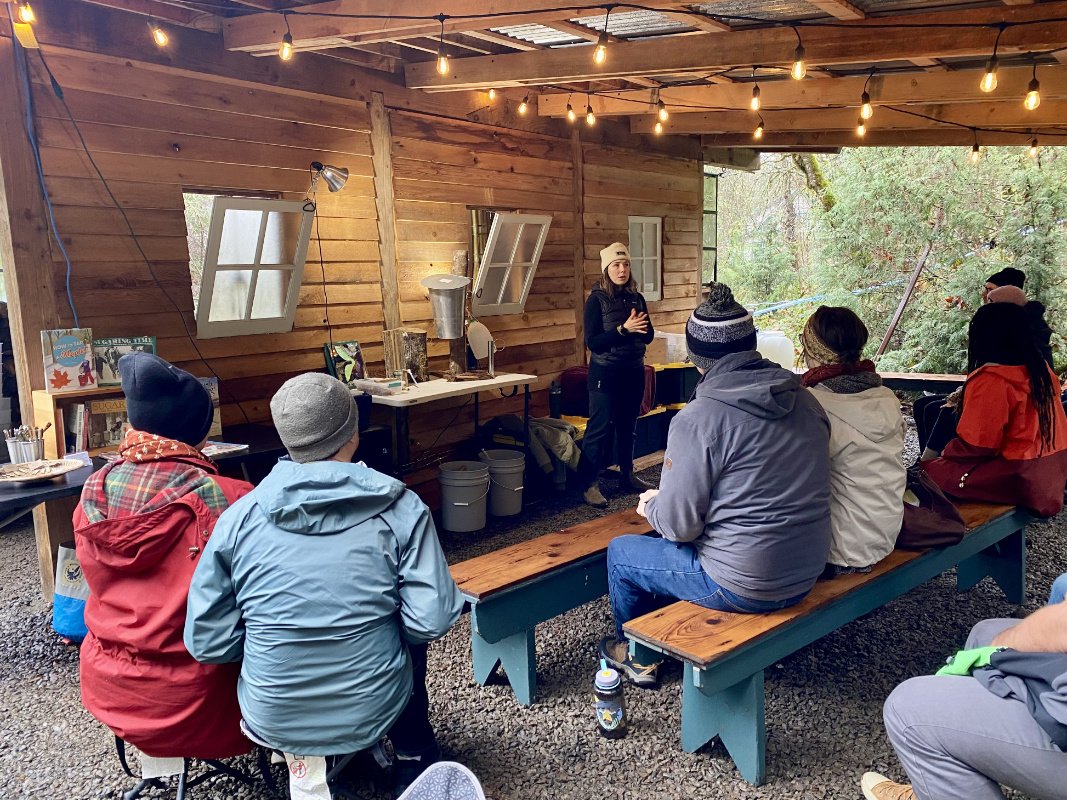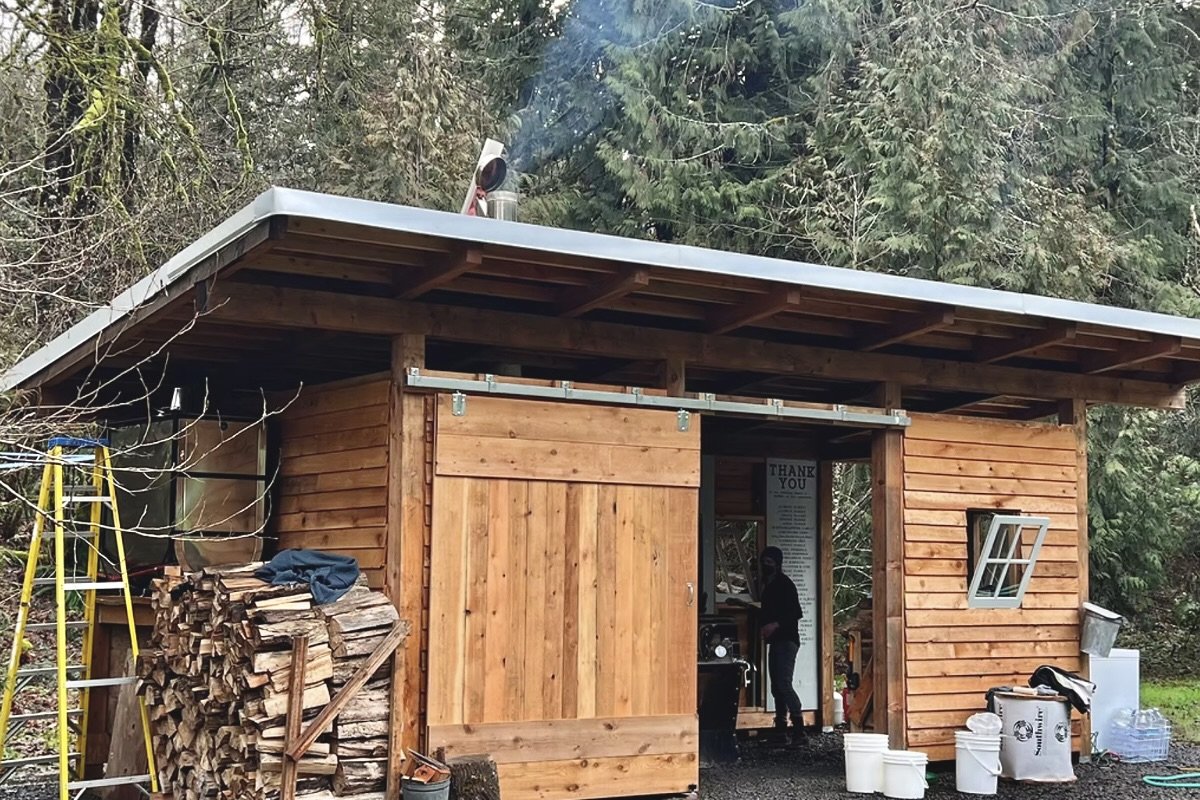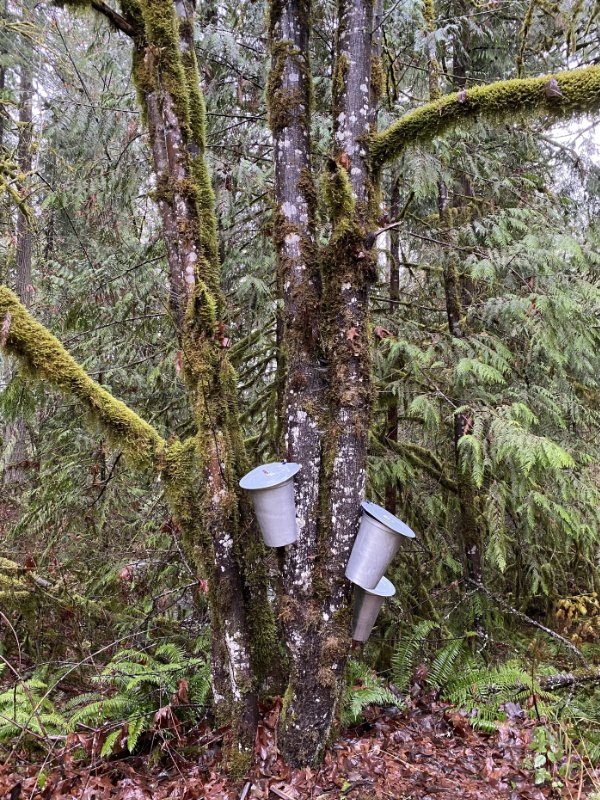The Pacific Northwest’s first maple sugaring collective invites community members to tap their trees, developing a new regional product and deeper connection with local ecosystems.

The Pacific Northwest’s first maple sugaring collective invites community members to tap their trees, developing a new regional product and deeper connection with local ecosystems.
April 30, 2025

Visitors join Ella Smoot on a winter day at Oregon Maple Project’s sugar shack at Camp Colton to learn about how maple syrup is made. (Photo credit: Elena Valeriote)
From late November to early March, Ella Smoot can usually be found in one of two places: the forest or the sugar shack. Like all maple syrup producers, her winter is a rush of running sap—cold mornings tapping trees and warm afternoons boiling the clear, watery liquid down to a golden, viscous substance. Though sugaring equipment has evolved over time, the basic process remains unchanged, as it has been practiced for centuries by Indigenous peoples in northeastern North America, from New England up through New Brunswick in Canada.
Expand your understanding of food systems as a Civil Eats member. Enjoy unlimited access to our groundbreaking reporting, engage with experts, and connect with a community of changemakers.
Already a member?
Login
What is unusual about Smoot’s work is not how it happens, but where. In her role as the executive director of the Oregon Maple Project, she is among the first to make maple syrup in the Pacific Northwest.
“It’s one of the founding reasons of the Oregon Maple Project: to make maple syrup with people.”
The Oregon Maple Project is based in the sugarbush of Camp Colton, an outdoor environmental education center located 45 minutes southeast of Portland. Its 85 forested acres, composed largely of bigleaf maples, as well as fir and cedar, are the traditional lands of the Molalla and Kalapuya people. Though some tribes historically used parts of the bigleaf maple trees for medicinal purposes, it is only in the past few years that the area’s residents have begun tapping the trees for sap.
Eliza Nelson, founder of the Oregon Maple Project, was inspired by her childhood growing up amid sugar maples on the East Coast. She produced her first bigleaf maple syrup in 2018 and founded the Oregon Maple Project two years later, with Smoot joining a year after that. Though thousands of miles from most sugar shacks, they are part of a growing group of bigleaf syrup enthusiasts in the region, actively supporting its continued growth—especially through their Sugaring Collective, which consists of 22 members, drawn together by an interest in local, sustainable food practices.
As international tariffs implemented by the Trump administration affect the flow of foreign imports into the U.S., this interest has taken on a new urgency. Approximately 70 percent of the world’s maple syrup is produced in Canada. While the U.S. produces the remaining 30 percent, our cravings outpace our supply—in the past decade, we have imported more than half of Canada’s total production of maple goods. As imports from Canada are currently subject to a 25 percent tariff, this may change quickly.
The Oregon Maple Project—which produced just 2 gallons of syrup this past winter—can’t come close to meeting national demand, but what the collective offers to its members is more than just a precious, sweet taste of the season: It’s an opportunity to form a more meaningful relationship with their natural surroundings.
Following her fourth sugaring season, Smoot chatted with Civil Eats about her experience as one of the first maple syrup producers in the Pacific Northwest, the differences between bigleaf and sugar maple syrups, and how the traditional practice of sugaring is changing with the climate.

Ella Smoot explains to the participants of a sugaring workshop how the boiler is used to transform bigleaf sap into maple syrup. (Photo credit: Elena Valeriote)
We’re an educational nonprofit with the mission of inspiring experiential learning, community partnership, and connection to nature through the local production of bigleaf maple syrup. We offer a range of programs for all ages, including workshops to teach about native plants and field trips to get kiddos outside more. The heart of our organization is the Sugaring Collective, which brings together individuals and families in Northwest Oregon who have access to bigleaf maples and an interest in learning how to produce syrup.
How does the maple collective work?
People pay a fee to participate during the sugaring season, and we provide training, equipment, and support throughout this time. We have a group email thread where people are able to ask any questions, any time, like, “What should I do here?” People collect sap from their own backyards and bring it to a community boil, where we then boil it down into syrup.
The gathering and the community aspect of it! It’s one of the founding reasons of the Oregon Maple Project: to make maple syrup with people. During the days of boiling, it gets drawn out. It’s a lot of work, but the first boil is always the best day. Through this process, people volunteer in different ways—helping make sure the sap doesn’t start foaming up, chopping wood, adding wood to the fire, thawing sap, checking the tank so that we don’t burn the sap. After all that, we bottle it.
Sugar maples are native to the eastern United States and parts of Canada, while bigleaf maples are native to the Pacific Northwest. We usually tag bigleaf maples in the spring and summer, which is when you can identify them using the flowers and leaves (which are bigger than sugar maples’). We also look at the symmetry of their branching patterns.

Steam rises from the Oregon Maple Project’s sugar shack at Camp Colton as members of the sugaring collective oversee the boiling process, reducing the sap from local bigleaf maple trees down to a dense, flavorful syrup. (Photo courtesy of Oregon Maple Project)
Both are used for syrup, but there are some key differences. Sugar maples thrive in colder climates, where they have more consistent freeze-thaw cycles, and are known for producing sap with a higher sugar content, around 2 to 3 percent. This makes the sap easier to boil down into syrup. In the Pacific Northwest, we have less predictable freeze-thaw weather patterns, and the sap of bigleaf maples has a lower sugar content—about 1 to 2 percent—so we need more sap to produce the same amount of syrup.
Bigleaf maple syrup tends to be darker than the amber color of the sugar maple syrup most people are used to. Its flavor is usually described as richer, with a hint of butterscotch and a floral undertone.
We try to boil it to all the same properties of traditional syrup, which is sweet and dense because it has to be 66.7 percent sugar. We make sure ours is that percentage of sugar. It’s hard to get there because it’s really scary to be close to burning it when you’re getting to those higher density sugar levels. But what we found is that because there’s less sugar content in our sap, we need to boil it for longer, which gives it a darker color, plus a more molasses-y flavor.
Definitely, and moving forward, a big goal of ours is to figure out how to collaborate more with local Native people. Eric Jones (a professor at Oregon State University and a leader of the region’s bigleaf maple syrup movement) has been reaching out to Native communities trying to figure out more about the local history around bigleaf maples.

Buckets are affixed to bigleaf maple trees to capture the sap, which will then be turned into syrup at the nearby sugar shack. (Photo credit: Elena Valeriote)
For us, Robin Wall Kimmerer’s book Braiding Sweetgrass is really inspiring, especially the chapter on tapping maple trees. In our workshops, we try to share what we know about Native practices, particularly those from the East Coast, where maple sugaring traditions have been passed down for generations.
We follow Honorable Harvest principles, which means taking only what is given, using everything we take, showing respect for the environment, and leaving something behind in return. For example, to make sure we are respecting the trees, we wait until their leaves are fully off at the beginning of the season before we tap. Then, we only tap them one spile per foot of diameter and we’re not tapping all the trees in the area.
We’re also taking a really small amount of sap compared to what the tree actually creates and we try to be super-duper clean so that bacteria doesn’t grow. We remove all the taps once the trees start budding so that they have all of their energy go towards flowering and making seeds.
In terms of giving back, I think it’s the way we’re educating people about how to practice tapping sustainably. Overall, research on the East Coast has shown that sugaring is really sustainable, and there is more research being done at Oregon State University to evaluate if it impacts the lifespan of a tree at all. They’ve done samples on trees that have been tapped thousands of times on the East Coast, and it hasn’t led to anything showing that it disrupts its ability to live a long, healthy life.
The sugar maple industry in the Northeast has a shorter season. Theirs lasts about six weeks in the spring after the deep freeze. For us, it’s late November or early December—whenever the first freeze is—through early March. And while their temperature patterns are more reliable and they’re working nonstop, we’re on and off, paying attention to the weather, collecting whenever there’s a freeze-thaw, then freezing all of our sap, because we don’t usually have enough for a boil. We have to do a lot of cleaning of all of our materials, because when there’s nothing flowing and it gets really warm during the winter, that’s a perfect place for bacteria to grow.
The maple syrup industry in general is interesting because there are a lot of small farm owners and woodland owners, and we serve people with all different political identities. Unfortunately, climate change has become a political identity.
At the Oregon Maple Project, we are curious about how the warming climate will impact the bigleaf maple trees. In Braiding Sweetgrass, Robin Wall Kimmerer talks about how sugar maples are going to start walking up to Canada and colder regions because they really like cold. My inkling is that bigleaf maples are really resilient and they’ll stay here, but as the climate gets warmer, we won’t be able to make as much syrup because we need the freeze-thaw cycle for the sap to run.
The beginning of the season in November is focused on getting all of our systems up and running, developing curriculum for our educational programs, setting up the equipment for the sugaring season, and waiting for that first freeze.
Then, throughout the sugaring season, from December through March, it’s really just chaos. I’m running programs—we do two field trips every week and workshops on the weekends—but also supporting the Sugar Collective, plus collecting sap and processing it through a reverse osmosis system. Sap is made out of water and sugar, so when you run it through reverse osmosis, it’s separating out the water molecules and the sugar molecules. This allows us to freeze a higher concentrate of sugar sap and that lessens the amount of boiling time that we need to get rid of the water and turn it into syrup.
We’re hoping to connect with more local Native communities to learn more of the history of this area, to keep growing the educational piece of our programs, and continue sharing the joy of making maple syrup from bigleaf maple trees.
This interview has been edited for length and clarity.

July 30, 2025
From Oklahoma to D.C., a food activist works to ensure that communities can protect their food systems and their future.
Like the story?
Join the conversation.